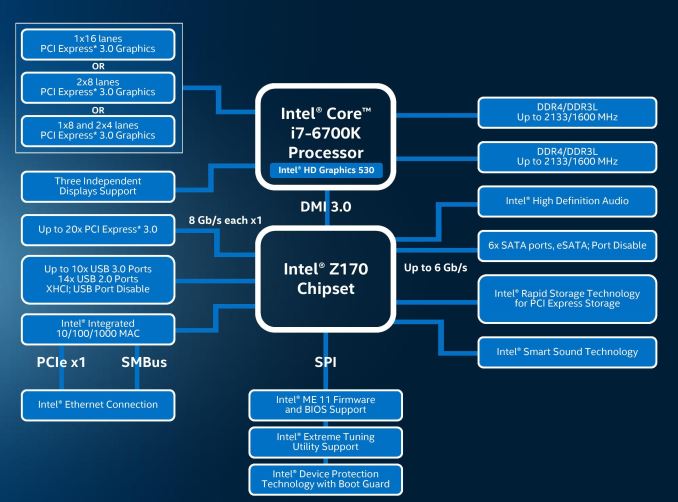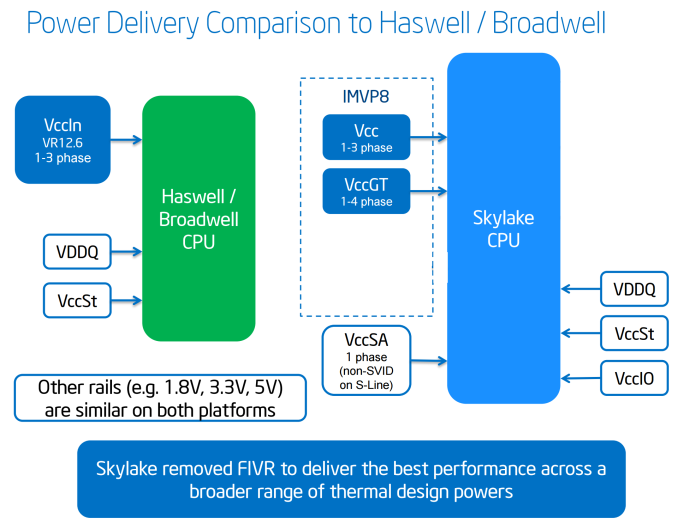The Intel 6th Gen Skylake Review: Core i7-6700K and i5-6600K Tested
by Ian Cutress on August 5, 2015 8:00 AM ESTThe Skylake CPU Architecture
As with any new Intel architecture, the devil is in the details. Previously at AnandTech we have been able to provide deep dives into what exactly is going on in the belly of the beast, although the launch of Skylake has posed a fair share of problems.
Nominally we rely on a certain amount of openness from the processor/SoC manufacturer in providing low level details that we can verify and/or explain. In the past, this information has typically been provided in advance of the launch by way of several meetings/consultations with discussions talking to the engineers. There are some things we can probe, but others are like a black box. The black box nature of some elements, such as Qualcomm’s Adreno graphics, means that it will remain a mystery until Pandora’s box is opened.
In the lead up to the launch of Intel’s Skylake platform, architecture details have been both thin on the ground and thin in the air, even when it comes down to fundamental details about the EU counts of the integrated graphics, or explanations regarding the change in processor naming scheme. In almost all circumstances, we’ve been told to wait until Intel’s Developer Forum in mid-August for the main reason that the launch today is not the full stack Skylake launch, which will take place later in the quarter. Both Ryan and I will be at IDF taking fastidious notes and asking questions for everyone, but at this point in time a good portion of our analysis comes from information provided by sources other than Intel, and while we trust it, we can't fully verify it as we normally would.
As a result, the details on the following few pages have been formed through investigation, discussion and collaboration outside the normal channels, and may be updated as more information is discovered or confirmed. Some of this information is mirrored in our other coverage in order to offer a complete picture in each article as well. After IDF we plan to put together a more detailed architecture piece as a fundamental block in analyzing our end results.
The CPU
As bad as it sounds, the best image of the underlying processor architecture is the block diagram:
From a CPU connectivity standpoint, we discussed the DDR3L/DDR4 dual memory controller design on the previous page so we won’t go over it again here. On the PCI-Express Graphics allocation side, the Skylake processors will have sixteen PCIe 3.0 lanes to use for directly attached devices to the processor, similar to Intel's previous generation processors. These can be split into a single PCIe 3.0 x16, x8/x8 or x8/x4/x4 with basic motherboard design. (Note that this is different to early reports of Skylake having 20 PCIe 3.0 lanes for GPUs. It does not.)
With this, SLI will work up to x8/x8. If a motherboard supports x8/x4/x4 and a PCIe card is placed into that bottom slot, SLI will not work because only one GPU will have eight lanes. NVIDIA requires a minimum of PCIe x8 in order to enable SLI. Crossfire has no such limitation, which makes the possible configurations interesting. Below we discuss that the chipset has 20 (!) PCIe 3.0 lanes to use in five sets of four lanes, and these could be used for graphics cards as well. That means a motherboard can support x8/x8 from the CPU and PCIe 3.0 x4 from the chipset and end up with either dual-SLI or tri-CFX enabled when all the slots are populated.
DMI 3.0
The processor is connected to the chipset by the four-lane DMI 3.0 interface. The DMI 3.0 protocol is an upgrade over the previous generation which used DMI 2.0 – this upgrade boosts the speed from 5.0 GT/s (2GB/sec) to 8.0 GT/s (~3.93GB/sec), essentially upgrading DMI from PCIe 2 to PCIe 3, but requires the motherboard traces between the CPU and chipset to be shorter (7 inches rather than 8 inches) in order to maintain signal speed and integrity. This also allows one of the biggest upgrades to the system, chipset connectivity, as shown below in the HSIO section.
CPU Power Arrangements
Moving on to power arrangements, with Skylake the situation changes as compared to Haswell. Prior to Haswell, voltage regulation was performed by the motherboard and the right voltages were then put into the processor. This was deemed inefficient for power consumption, and for the Haswell/Broadwell processors Intel decided to create a fully integrated voltage regulator (FIVR) in order to reduce motherboard cost and reduce power consumption. This had an unintended side-effect – while it was more efficient (good for mobile platforms), it also acted as a source of heat generation inside the CPU with high frequencies. As a result, overclocking was limited by temperatures and the quality of the FIVR led to a large variation in results. For Skylake on the desktop, the voltage regulation is moved back into the hands of the motherboard manufacturers. This should allow for cooler processors depending on how the silicon works, but it will result in slightly more expensive motherboards.
A slight indication of this will be that some motherboards will go back to having a large amount of multiplexed phases on the motherboard, and it will allow some manufacturers to use this as a differentiating point, although the usefulness of such a design is sometimes questionable.












477 Comments
View All Comments
experttech - Monday, August 10, 2015 - link
I have a Sandy Bridge 2600K running on a Asus H67 EVO motherboard, so not overclocked. My motherboard is slowly dying. First the obboard sound died, then the reset is now working. Now I am wondering whether to upgrade the motherboard to an overclockable Sandy Bridge motherboard or jump the wagon to 6700K. I mostly do Video Editing and Encoding, no gaming. or wait till the motherboard dies completely and hope SkyLake E or Kaby Lake is out by that time. Any suggestions?sonny73n - Wednesday, August 12, 2015 - link
2600K is an excellent chip. I'd rather have the i7-2600K than the new i5-6600K. You should get a new MB Z77 but there's not many still available now. I only saw 1 Z77 on Newegg, it's the Asrock and I think it costs around $160. You can also find used Z68 and Z77 MBs on Amazon or eBay but I wouldn't recommend it. Video editing with the 2600K is a piece of cake and x264 encoding is not bad either. Keep the chip and spend your money on a good video card and a nice 4K ips monitor.experttech - Thursday, August 13, 2015 - link
Thanks for your reply. I too realized the same, I did notice the only Z77 Asrock motherboard (which is an excellent motherboard by the way) but for the price, I can't justify buying it especially since so many options are available in the new platform. One interesting thing I noticed is that with the newer instruction sets, my laptop with i5 5200U actually renders some frames very fast but overall, my i7 2600K renders the finished movie quicker. So though there are IPC improvements in the newer chips, the basic features (performance, mutithreading etc) haven't changed night and day. Of course I am comparing a Sandy bridge i7 to a lower clocked Broadwell i5 but I am not sure if there will be a tangible difference upgrading to SkyLake as of now. So you are right my friend and thanks for the advice!I do have a 1440p monitor and its amazing how much real estate you get going from 1080p. Definitely one of the best upgrades I made. I will look into a 4K monitor as they have come down quite a bit in price.
phillipstuerzl - Monday, August 10, 2015 - link
Hi,On your 5th page, under Test Setup, you list the i5 6600K as being 4C/8T. This is incorrect. It is not hyperthreaded, and only 4C/4T.
Great article!
Ryan Smith - Tuesday, August 11, 2015 - link
Thanks!DannyDan - Monday, August 10, 2015 - link
So do we expect the 1151 socket to have a few good upgraded processors down the road? It really sucked getting a socket 1156 CPU.mdw9604 - Tuesday, August 11, 2015 - link
Moore's law is a crock of $%!24. 7 years later and Intel still hasn't doubled the performance the i7 870. Core for Core.The may be able to cram more transistors into a smaller space, but doesn't mean better performance.
Oxford Guy - Thursday, August 13, 2015 - link
It's funny how every time it fails people say it is being "adjusted", "extended", "massaged", "modified", or something like that. Either it works or it doesn't. It should be called Moore's Heuristic = "process density increases over time" (duh).ES_Revenge - Saturday, August 15, 2015 - link
You misunderstand Moore's Law. Moore's law has nothing [necessarily] to do with performance. Moore's law only states that the number of transistors possible in a given space will double every two years. It also doesn't just apply to Intel and mainstream CPUs, it applies to *all* integrated circuits. Everything from CPUs to EEPROMS, to SOCs, to microcontrollers, to image sensors...etc. these things are all included as they're all ICs. So, on average, it still holds AFAIK.Whether or not a 14nm chip outperforms, or how much it outperforms, a 28nm one (there wasn't one for Intel, but Sandy was 32nm) is NOT what Moore's Law predicts. Other people have construed this "Law" to mean things about performance (including some guy at Intel that once said performance would double every xx months--totally wrong and not what Moore's Law states anyway), but it's not about performance and certainly not just about desktop CPUs.
You can't say something is a "crock of $%!24" if you don't know what it's about to begin with.
Kutark - Thursday, August 20, 2015 - link
Unfortunately, whether or not someone understands something has never stopped someone from speaking their mind on it. Hell, look at pretty much every election under the sun. The vast majority of people who vote in them couldn't even give you a basic rundown of the issues at hand, yet they sure do have an opinion on it...